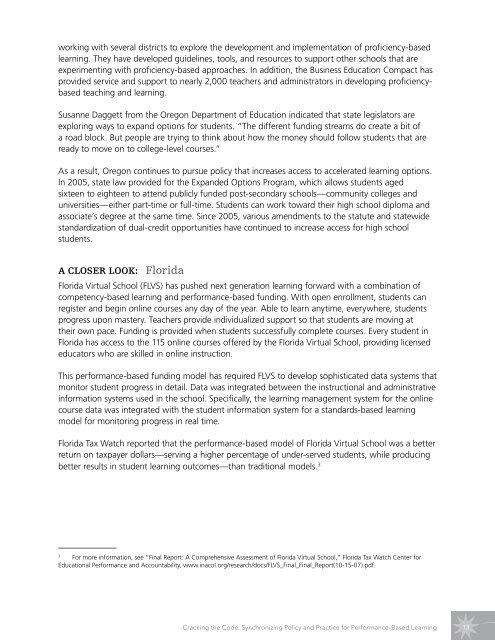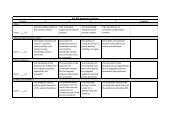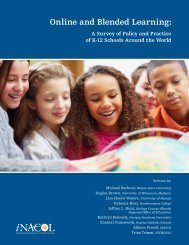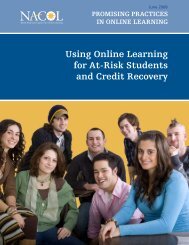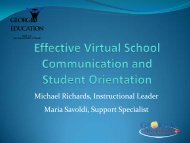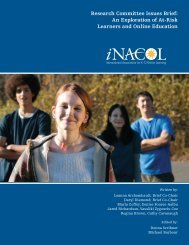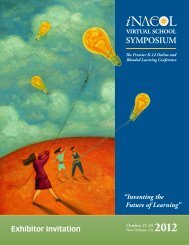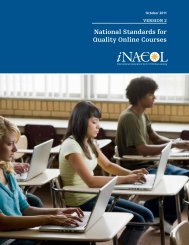Cracking the Code: - The Nellie Mae Education Foundation
Cracking the Code: - The Nellie Mae Education Foundation
Cracking the Code: - The Nellie Mae Education Foundation
- No tags were found...
You also want an ePaper? Increase the reach of your titles
YUMPU automatically turns print PDFs into web optimized ePapers that Google loves.
working with several districts to explore <strong>the</strong> development and implementation of proficiency-basedlearning. <strong>The</strong>y have developed guidelines, tools, and resources to support o<strong>the</strong>r schools that areexperimenting with proficiency-based approaches. In addition, <strong>the</strong> Business <strong>Education</strong> Compact hasprovided service and support to nearly 2,000 teachers and administrators in developing proficiencybasedteaching and learning.Susanne Daggett from <strong>the</strong> Oregon Department of <strong>Education</strong> indicated that state legislators areexploring ways to expand options for students. “<strong>The</strong> different funding streams do create a bit ofa road block. But people are trying to think about how <strong>the</strong> money should follow students that areready to move on to college-level courses.”As a result, Oregon continues to pursue policy that increases access to accelerated learning options.In 2005, state law provided for <strong>the</strong> Expanded Options Program, which allows students agedsixteen to eighteen to attend publicly funded post-secondary schools—community colleges anduniversities—ei<strong>the</strong>r part-time or full-time. Students can work toward <strong>the</strong>ir high school diploma andassociate’s degree at <strong>the</strong> same time. Since 2005, various amendments to <strong>the</strong> statute and statewidestandardization of dual-credit opportunities have continued to increase access for high schoolstudents.A CLOSER LOOK: FloridaFlorida Virtual School (FLVS) has pushed next generation learning forward with a combination ofcompetency-based learning and performance-based funding. With open enrollment, students canregister and begin online courses any day of <strong>the</strong> year. Able to learn anytime, everywhere, studentsprogress upon mastery. Teachers provide individualized support so that students are moving at<strong>the</strong>ir own pace. Funding is provided when students successfully complete courses. Every student inFlorida has access to <strong>the</strong> 115 online courses offered by <strong>the</strong> Florida Virtual School, providing licensededucators who are skilled in online instruction.This performance-based funding model has required FLVS to develop sophisticated data systems thatmonitor student progress in detail. Data was integrated between <strong>the</strong> instructional and administrativeinformation systems used in <strong>the</strong> school. Specifically, <strong>the</strong> learning management system for <strong>the</strong> onlinecourse data was integrated with <strong>the</strong> student information system for a standards-based learningmodel for monitoring progress in real time.Florida Tax Watch reported that <strong>the</strong> performance-based model of Florida Virtual School was a betterreturn on taxpayer dollars—serving a higher percentage of under-served students, while producingbetter results in student learning outcomes—than traditional models. 33For more information, see “Final Report: A Comprehensive Assessment of Florida Virtual School,” Florida Tax Watch Center for<strong>Education</strong>al Performance and Accountability, www.inacol.org/research/docs/FLVS_Final_Final_Report(10-15-07).pdf.<strong>Cracking</strong> <strong>the</strong> <strong>Code</strong>: Synchronizing Policy and Practice for Performance-Based Learning 13


